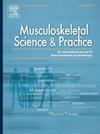主动行为物理治疗干预(ABPI)治疗慢性非特异性颈部疼痛的有效性:一项内部先导集群随机双盲临床试验
IF 2.2
3区 医学
Q1 REHABILITATION
引用次数: 0
摘要
慢性非特异性颈部疼痛(CNSNP)引起疼痛和残疾,是一个严重的公共卫生问题。根据我们之前的试验数据,积极的行为物理治疗干预(ABPI)可能是一种有效的干预措施来管理CNSNP患者。迄今为止,CNSNP人群尚未使用ABPI进行调查。目的初步评价ABPI在CNSNP患者治疗中的潜在有效性和可行性。设计一项在4家泰国公立医院进行的内部试点集群随机、双盲、平行双臂(ABPI与标准物理治疗干预:SPI)临床试验。方法采用颈部残疾指数(NDI)、数值疼痛评定量表(NPRS)、颈椎活动度、恐惧回避信念问卷、中枢致敏性量表(CSI)和短表-36对40名参与者(每组20人)进行基线和基线后3个月的面对面评估。结果参与者的平均(标准差)年龄为38.1(7.8)岁。ABPI在所有结果测量中均显示组内显著改善,NDI、NPRS和CSI在SPI中显示显著改善(p≤0.05)。对于组间比较,除CSI外,ABPI组的所有结局指标均显著优于SPI (p≤0.05)。最后,完全康复的参与者(考虑到NDI≤4/50)ABPI(15/20参与者,75%)大于SPI(7/20参与者,35%)。这些来自内部试点研究的有希望的发现支持继续收集数据进行最终的III期试验(n = 120),以评估ABPI对CNSNP管理的有效性。本文章由计算机程序翻译,如有差异,请以英文原文为准。
Effectiveness of an active behavioural physiotherapy intervention (ABPI) for chronic non-specific neck pain: an internal pilot cluster-randomised double-blind clinical trial
Background
Chronic non-specific neck pain (CNSNP) causes pain and disability, contributing to a serious public health problem. An active behavioural physiotherapy intervention (ABPI) may be an effective intervention to manage patients with CNSNP based on our previous trial data. To date, a CNSNP population has not been investigated with an ABPI.
Objectives
To preliminarily evaluate the potential effectiveness and feasibility of the ABPI for the management of patients with CNSNP.
Design
An internal pilot cluster-randomised double-blind, parallel 2-arm (ABPI vs standard physiotherapy intervention: SPI) clinical trial across 4 Thai public hospitals.
Methods
Forty participants (20 each arm) were recruited and face-to-face assessed at baseline and 3-month follow-up post baseline using the neck disability index (NDI), numerical pain rating scale (NPRS), cervical range of motion, fear-avoidance beliefs questionnaire, central sensitisation inventory (CSI) and short form-36.
Results
The mean (standard deviation) age of participants was 38.1 (7.8) years. The ABPI demonstrated significant within group improvement in all outcome measures and the NDI, NPRS and CSI illustrated significant improvement for the SPI (p ≤ 0.05). For the comparison between groups, all outcome measures were significantly better in the ABPI arm compared to the SPI (p ≤ 0.05), except the CSI. Finally, the number of fully recovered participants (considering the NDI ≤ 4/50) was greater for the ABPI (15/20 participants, 75 %) than the SPI (7/20 participants, 35 %).
Conclusion
These promising findings from an internal pilot study support continued data collection to conduct the definitive phase III trial (n = 120) to evaluate the effectiveness of the ABPI for the CNSNP management.
求助全文
通过发布文献求助,成功后即可免费获取论文全文。
去求助
来源期刊

Musculoskeletal Science and Practice
Health Professions-Physical Therapy, Sports Therapy and Rehabilitation
CiteScore
4.10
自引率
8.70%
发文量
152
审稿时长
48 days
期刊介绍:
Musculoskeletal Science & Practice, international journal of musculoskeletal physiotherapy, is a peer-reviewed international journal (previously Manual Therapy), publishing high quality original research, review and Masterclass articles that contribute to improving the clinical understanding of appropriate care processes for musculoskeletal disorders. The journal publishes articles that influence or add to the body of evidence on diagnostic and therapeutic processes, patient centered care, guidelines for musculoskeletal therapeutics and theoretical models that support developments in assessment, diagnosis, clinical reasoning and interventions.
 求助内容:
求助内容: 应助结果提醒方式:
应助结果提醒方式:


